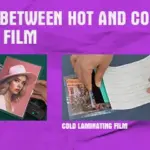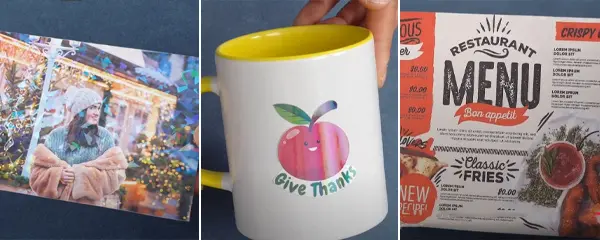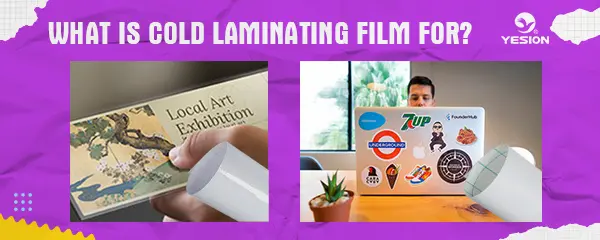
Matte vs Glossy: Which Sticker Paper to choose for printing Labels?
2025-01-03
Difference Between Hot and Cold Laminating Film
2025-01-10Cold laminating film is a versatile material used extensively in the printing, graphics, and signage industries. With the growing demand for durable and high-quality finishes on a wide range of printed materials, cold laminating films have become an essential component for both professionals and hobbyists alike. In this comprehensive guide, we will explore what cold laminating film is, its applications, advantages, and how to choose the right one for your specific needs.
Cold Laminating Film: What It Is and How It Works
Cold laminating film is a protective, adhesive-coated film designed to be applied to printed surfaces without the need for heat. Unlike hot laminating, which requires a thermal process to activate the adhesive, cold lamination works by simply applying pressure. This makes cold laminating a more accessible and cost-effective solution for those who may not have access to specialized heat laminating equipment.
The cold lamination process involves placing the film over the printed material and then applying pressure using hand roller to ensure a firm bond. The film’s adhesive coating is activated by the pressure, adhering to the print surface without any heat.
Types of Cold Laminating Film
Cold laminating films are available in several varieties to suit different applications. The primary types include:
- Glossy Cold Laminating Film: This film provides a shiny, reflective surface that enhances the vibrancy of printed materials. It is often used for promotional materials, photo prints, and signage that requires a high-gloss finish.
- Matte Cold Laminating Film: Offering a non-reflective, smooth finish, matte cold laminating film is perfect for prints that need a more subtle and sophisticated look. It is ideal for projects like brochures, business cards, and educational materials.
- Textured Cold Laminating Film: This variant adds a tactile texture to the surface of printed materials. It’s commonly used for artistic prints and promotional items where a unique feel is desired.
Applications of Cold Laminating Film
Cold laminating films are used in a wide range of industries, each benefiting from the material’s ability to protect printed items and extend their longevity. Below are some of the most common applications:
1. Signage and Banners
Cold laminating film is a popular choice for signage and banners due to its ability to provide a durable and long-lasting protective layer. Whether it’s an outdoor advertisement or an indoor display, cold laminating film helps to protect the prints from UV damage, moisture, and general wear and tear.
2. Photo Protection
Photographs and artwork are often laminated with cold laminating film to prevent damage from handling, fading, and environmental factors. The film acts as a shield, maintaining the quality of the image for years. Additionally, glossy cold laminating films enhance the vibrancy and clarity of the prints.

Applications of Cold Laminating Film
3. Document Preservation
Cold laminating is frequently used for preserving important documents such as certificates, legal papers, and identification cards. The film helps to keep documents intact, providing a layer of protection from dirt, moisture, and handling, while also making them more resistant to tearing and wear.
4. Retail and Promotional Materials
Businesses in retail often use cold laminating film for product tags, business cards, flyers, and brochures. The film not only improves the durability of these items but also enhances their appearance, making them more appealing to customers.
5. Packaging Materials
Cold laminating film is also used in packaging to protect labels and graphics. It ensures that product packaging remains visually appealing even after long periods of storage or handling, maintaining both the quality and aesthetic of the packaging design.
How to use yesion cold laminating film?
Advantages of Cold Laminating Film
Cold laminating offers several key advantages over other methods of lamination. These benefits make cold laminating an attractive option for a variety of industries and uses.
1. No Need for Heat
One of the biggest advantages of cold laminating is that it does not require heat. This means there is no risk of heat damage to heat-sensitive materials such as photographs, certain papers, and inks. It also eliminates the need for expensive laminating machines that use heat.
2. Faster Process
Since no heat is involved, cold laminating tends to be a quicker process. This can significantly improve turnaround times for businesses that need to laminate large volumes of material, especially in fast-paced environments like print shops.
3. Cost-Effective
Cold lamination typically requires less energy than hot lamination, making it a more cost-effective option for those looking to laminate materials in-house. The initial investment in equipment is also lower, as cold laminators tend to be less expensive than their hot laminating counterparts.
4. Ideal for Sensitive Materials
Cold laminating is a safer option for materials that could be damaged by heat. This includes photos, delicate papers, and certain printed products with inks that could smudge or fade under heat. Cold laminating film preserves the integrity of these materials while still providing a protective layer.
5. Variety of Finishes
As mentioned earlier, cold laminating films come in a variety of finishes, including glossy, matte, textured. This versatility allows businesses to choose the finish that best suits their specific needs, whether it’s for marketing materials, artwork, or signage.
How to Choose the Right Cold Laminating Film
Selecting the appropriate cold laminating film for your project is crucial to ensuring optimal results. Here are a few factors to consider:
1. Type of Material
Consider the type of material you are laminating. If you are working with photographs or artwork, a glossy or matte finish might be the best choice. For documents or signage, you may want to use anti-glare or textured film.
2. Size of the Material
Ensure that the cold laminating film you select is compatible with the size of the materials you wish to laminate. Cold laminating films come in various widths and lengths, so you need to make sure the film is large enough to cover the entire area of your print.
3. Durability Requirements
If the laminated item will be exposed to outdoor conditions or heavy handling, look for cold laminating films that offer UV protection and are designed to resist fading, tearing, and moisture.
4. Ease of Application
Some cold laminating films come with self-adhesive backing, making them easier to apply. However, if you plan to laminate large or multiple items, you may need a laminating machine to ensure consistent pressure and smooth application.
Cold laminating film is an essential tool for preserving and enhancing the quality of printed materials. Its ability to protect against moisture, dirt, and fading, combined with its versatility and ease of use, makes it a popular choice in many industries. Whether for signage, photos, documents, or promotional materials, cold laminating offers an effective and affordable solution for long-lasting protection.

